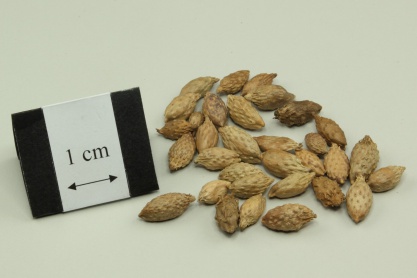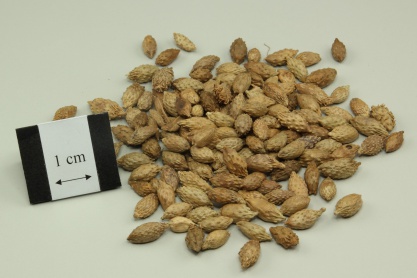- ENG
- Siberian Cocklebur Fruit
- LATIN
- Xanthii Fructus
| Medicinal Group | Wind-cold-dispersing medicinal |
|---|---|
| Source | Dried ripe bur with involucre of Xanthium sibiricum Patr. (Fam. Compositae) |
| Nature and Flavors | pungent, bitter; warm; toxic |
| Meridian Affinity | Lung |
| Actions | To dipel wind and damp, and relieve nasal obstruction |
Family
Part used
Indications
Headache caused by exterior wind-cold; rhinitis or sinusitis with nasal discharge; urticaria with itching; fixed impediment and spasm
Research Findings
- Fructus Xanthii is commonly used in rhinology, especially used in treatment of chronic rhinitis and sinusitis. But Fructus Xanthii is toxicant, and it maybe result in poisoning when used excessively, without preparation or in inappropriate preparation. [1]
- Xincang Decoction (consisting of Fructus Xanthii) can decrease the levels of peripheral eosinophil and interleukin 5 and improve the pulmonary function in treating chronic airway inflammation in children with bronchial asthma in remission stage.[2]
Cautions
Contraindication with headache due to blood deficiency. May cause poisoning when overdose is taken
Report on adverse effect
Headache, dizziness, nausea, vomiting, abdominal pain, diarrhea, severe cases coma, convulsions and even death. Cardiac and liver dysfunction [6]
Repose, pilo-erection, cyanosis, intention tremor, respiratory inhibition, loss of righting reflex and convulsion, abdominal respiration, intermittent convulsions, incontinence [4]. Hepatotoxicity [5]
Research Findings
- Fructus Xanthii is commonly used in rhinology, especially used in treatment of chronic rhinitis and sinusitis. But Fructus Xanthii is toxicant, and it maybe result in poisoning when used excessively, without preparation or in inappropriate preparation. [1]
- Changes in body weight and blood cell and BUN and Scr occurred in middle and high dosage groups. Adversed effects or even death cases occurred after continuous administration of 3 times or 9 times the permitted dosage of Xanthii Fructus and processed Xanthii Fructus for 2 months. [3]
Reference
Reference
- Zhang XM, Zhang ZH. (2003). The study of intoxication and toxicity of Fructus Xanthii. Zhong Xi Yi Jie He Xue Bao. , 1(1):71-3.
- Zhu HH, Chen YP, Yu JE, Wu M, Li Z. (2005). Therapeutic effect of Xincang Decoction on chronic airway inflammation in children with bronchial asthma in remission stage. Zhong Xi Yi Jie He Xue Bao. , 3(1):23-7.
- Yu J, Song M, Wang J, Li Y, Lin P, Que L, Bao Z. (2013) In vitro cytotoxicity and in vivo acute and chronic toxicity of Xanthii Fructus and its processed product. Biomed Res. Int. 2013: 403491
- Yan L, Zhang T, Zhao J, Song J, Hua H, Li L (2012) Comparative study on acute toxicity of four extracts from Xanthii Fructus in mice. Zhongguo Zhongyao Zazhi, 37, 15, 2228-2231.
- Wang Y, Han T, Xue LM, Han P, Zhang QY, et al. (2011) Hepatotoxicity of kaurene glycosides from xanthium strumarium L. fruits in mice. Pharmazie 66: 445–449.
- Zhang X, Zhang Z (2003) The study of intoxication and toxicity of Fructus Xanthii. Zhong xi yi jie he xue bao = Journal of Chinese integrative medicine, 1, 1, 71.
- Huang MH, Wang BS, Chiu CS, Amagaya S, Hsieh WT, Huang SS, Shie PH, Huang GJ (2011) Antioxidant, antinociceptive, and anti- inflammatory activities of Xanthii Fructus extract. J.Ethnopharmacol., 135, 2, 545-552.
- 馬藏、程媛、高天、李涓 (2012)。<蒼耳子和辛夷配伍前後的急性毒性與抗炎實驗研究>。成都中醫藥大學學報,3。












